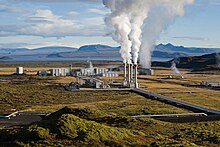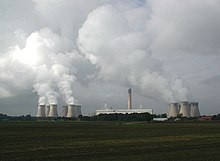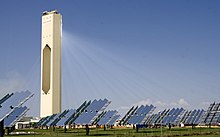
Back محطة حرارية Arabic İstilik elektrik stansiyası Azerbaijani ایستیلیک الکتریک مرکزی AZB Цеплавая электрычная станцыя Byelorussian Цеплавая электрычная станцыя BE-X-OLD Топлоелектрическа централа Bulgarian Termoelektrana BS Central tèrmica Catalan ھێزگەی گەرمایی CKB Tepelná elektrárna Czech





A thermal power station is a type of power station in which heat energy is converted to electrical energy. In a steam-generating cycle heat is used to boil water in a large pressure vessel to produce high-pressure steam, which drives a steam turbine connected to an electrical generator. The low-pressure exhaust from the turbine enters a steam condenser where it is cooled to produce hot condensate which is recycled to the heating process to generate more high pressure steam. This is known as a Rankine cycle.
The design of thermal power stations depends on the intended energy source: fossil fuel, nuclear and geothermal power, solar energy, biofuels, and waste incineration are all used. Certain thermal power stations are also designed to produce heat for industrial purposes; for district heating; or desalination of water, in addition to generating electrical power.
Fuels such as natural gas or oil can also be burnt directly in gas turbines (internal combustion). These plants can be of the open cycle or the more efficient combined cycle type.
© MMXXIII Rich X Search. We shall prevail. All rights reserved. Rich X Search